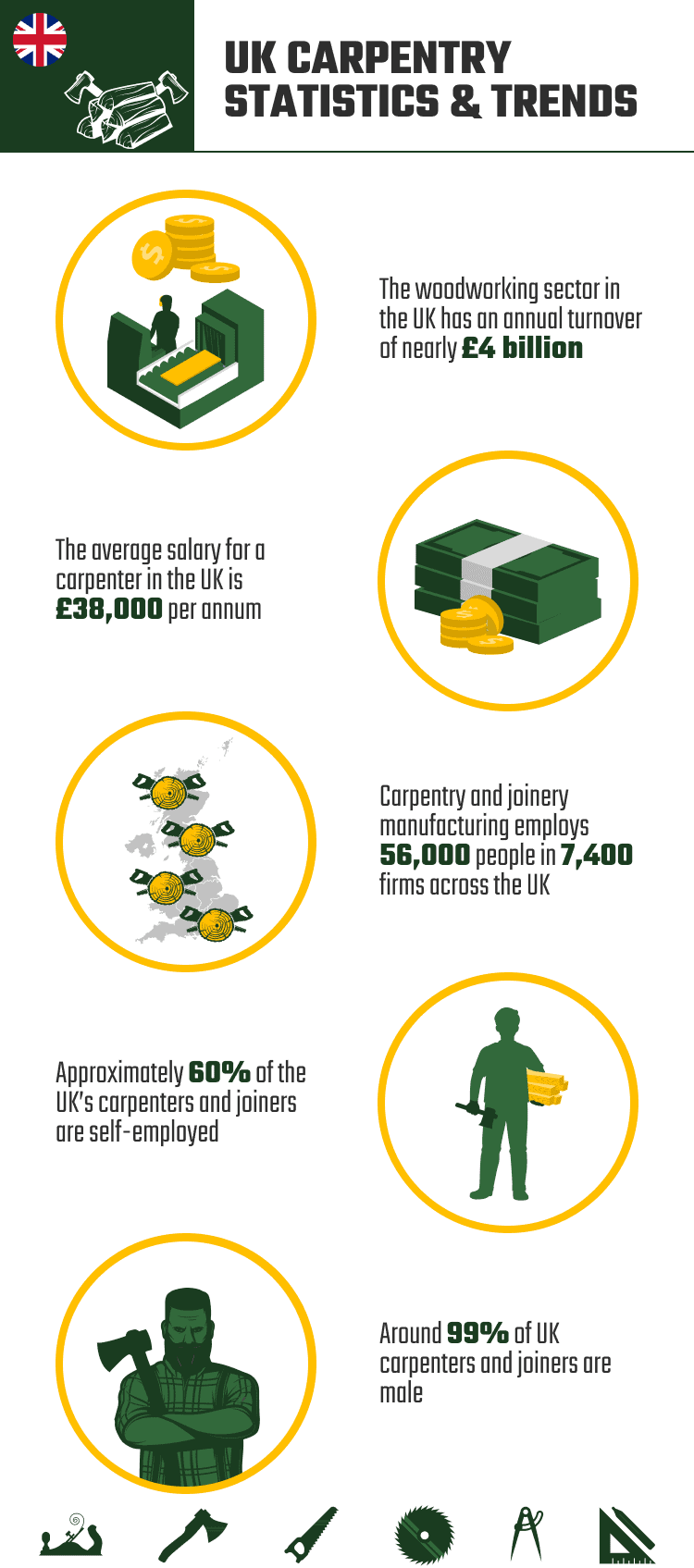12 Carpentry Statistics and Trends in the UK: 2025 Update
-
Pete Ortiz
- Last updated:

Note: This article’s statistics come from third-party sources and do not represent the opinions of this website.
Carpentry and joinery in the UK involve the manufacture, installation, and repair of primarily timber products. Carpenters and joiners are most often employed on construction sites as well as in workshops. The majority of carpenters and joiners are self-employed, although 40% have part-time or full-time jobs in the industry, and the workforce is dominated by male workers who make up 99% of skilled tradespeople.
Like many industries, but especially those involved in construction, the carpentry industry endured a very difficult time during Covid, and while there has been some recovery, the industry is still expected to contract in 2023 before growing again between 2024 and 2026.
Below are 12 carpentry statistics and trends in the UK, including figures on the overall construction industry and data relating to carpentry and joinery careers.
Click below to jump ahead:
The 12 Carpentry Statistics and Trends in the UK
- The construction industry contributed more than £35 billion to the UK economy in Q2 2022.
- The construction industry is expected to contract in 2023 but grow between 2024 and 2026.
- Balfour Beatty is the largest company in the construction industry by annual turnover.
- There are around 28,000 joinery installation businesses.
- There are 5,000 firms in the woodworking industry.
- The woodworking sector has an annual turnover of nearly £4 billion.
- The average salary for a carpenter is £38,000 per annum.
- Carpentry and joinery manufacturing employs 56,000 people in 7,400 firms.
- Approximately 60% of carpenters and joiners are self-employed.
- Employment of carpenters and joiners is expected to fall between now and 2027.
- 99% of carpenters and joiners are male.
- Female joiners and carpenters earn a higher hourly rate than males.

General Construction Industry Trends
1. The construction industry contributed more than £35 billion to the UK economy in Q2 2022
(Statista 1)
The construction industry suffered heavily during COVID-19 and pandemic lockdowns. Construction jobs were put on hold and many businesses suffered. Even as lockdowns came to an end, there was an ongoing struggle with supply issues as manufacturers worked to catch up with the backlog.
However, 2022 has seen a marked recovery. In the second quarter, the construction industry posted a Gross Value Added (GVA) of £36.75 billion. In the previous quarter, the figure was £34.5 billion, and 2 years prior in the second quarter of 2020, the figure was just £20.15 billion.

2. The construction industry is expected to contract in 2023 but grow between 2024 and 2026
(Global Data)
Despite this recovery, the construction industry as a whole is expected to contract by 1.9% in 2023. This contraction comes despite the industry outperforming expectations in recent quarters and as a result of factors including increasing interest rates and an increase in energy and material costs.
However, following this contract, it is expected that construction projects will increase and there will be annual growth of 2.9% between 2024 and 2026.
3. Balfour Beatty is the largest company in the construction industry by annual turnover
(Statista 2)
The construction industry is dominated by several large firms. Balfour Beatty is the largest company, by annual turnover, which was more than double that of its biggest competitor, Kier Group.
However, Balfour Beatty’s 2021 turnover was £330 million less than in 2020. Balfour Beatty’s revenue is higher than the combined total of its next two rivals, Kier Group and Morgan Sindall Group.

Joinery and Carpentry
4. There are around 28,000 joinery installation businesses
(IBIS World)
Joinery installation includes the fitting of doors and windows, kitchens, staircases, shop fittings, and other construction products made primarily from timber. As well as products used in the construction of new properties, it also includes new products fitted to existing properties and is a major part of the carpentry industry. There are nearly 30,000 joinery installation businesses currently in the UK.
5. There are 5,000 firms in the woodworking industry
(BWF)
The woodworking industry is involved in the cutting and processing of wood as the making of items from that wood. It includes cabinetry and furniture making as well as the manufacture of door and window frames and other items. 5,000 firms in the UK are considered to be in the woodworking industry, making it a significant part of the overall carpentry sector.

6. The woodworking sector has an annual turnover of nearly £4 billion
(BWF)
The woodworking sector has an annual turnover of approximately £4 billion a year. The businesses involved in this sector produce items including architectural joinery as well as window and door frames. Virtually every construction project and new build requires timber products, which makes woodworking a vital job.
Carpentry Employment Figures
7. The average salary for a carpenter is £38,000 per annum
(Reed)
The most common route into a career in carpentry is via an apprenticeship. To embark on an advanced apprenticeship, candidates usually need 5 GCSEs at grades 9 to 4, including English and maths. College courses, such as a T Level in On-Site Construction, or a Diploma in Bench Joinery can also lead to roles in carpentry. A typical starting salary in the field is around £17,000, while the average salary for a skilled carpenter is £38,000 per annum.

8. Carpentry and joinery manufacturing employs 56,000 people in 7,400 firms
(BWF)
The construction industry, as a whole, employs 10% of the UK’s total workforce and there are many jobs in carpentry. A total of 7,400 firms operate within the carpentry and joinery manufacturing sector and these firms employ a combined total of 56,000 people.
9. Approximately 60% of carpenters and joiners are self-employed
(Career Smart)
However, while there are tens of thousands of potential employers within the industry, the majority of carpenters and joiners are self-employed. 59% of the workforce work for themselves. A further 40% are full-time employees and less than 1% work as part-time employees for another firm.

10. Employment of carpenters and joiners is expected to fall between now and 2027
(Career Smart)
The construction industry is expected to contract in 2023 and this is likely to impact the availability of jobs within the industry, along with other contributing factors. There are currently around 240,000 carpenters and joiners and this figure is expected to drop to 237,000 by 2027. London is the area of the country with the most carpenters and the highest demand, followed by the South East, South West, and North West respectively.
11. 99% of carpenters and joiners are male
(Career Smart)
The construction industry is male-dominated, and this is equally true of carpentry and joinery. 99% of the workforce is male.

12. Female joiners and carpenters earn a higher hourly rate than males
(Career Smart)
While most of the workforce is male, female carpenters and joiners tend to earn more per hour and work fewer hours than their male counterparts. Male joiners work an average of 45 hours per week, compared to the 30 hours worked every week by a typical female joiner. With an average annual salary of £28,000 for men and £25,500 for women, this means that women earn an average of £16.33 per hour compared to the £11.78 per hour earned by men.
Frequently Asked Questions About Carpentry in the UK

How much do carpenters make in the UK?
The typical salary for a carpenter depends on a lot of factors, but especially experience and location. London has the highest average salary of £33,000 while the North West of England has the lowest at £24,500. The North West also has the highest average hours worked, which puts it firmly at the bottom of the list for average hourly earnings. By age, 20-year-olds have the lowest earnings with an average salary of just £16,000, although this is likely because many carpenters of this age are still working as apprentices. 48-year-olds have the highest average salary and earn £32,000. (Career Smart)
Are carpenters in demand in the UK?
There is consistent demand for carpenters and joiners because there are always new building projects in the pipeline. However, the number of jobs in the industry is expected to decline over the next five years.
What qualifications do I need to become a carpenter?
There are different paths to becoming a carpenter with the two main routes being via an apprenticeship or a relevant college course. In general, applicants will need some GCSEs, typically 5 at grades 9 to 4 and including English and maths, to get an advanced apprenticeship. An apprenticeship has the advantage of offering experience while training.
Can I become a carpenter at 40?
There is no upper age limit to becoming a carpenter, but you will need a decent level of overall physical fitness and general health. Carpentry can be quite demanding, but while most carpenters do start when they are young, there is no reason that a 40-year-old can’t retrain to become a joiner.
Conclusion
Carpentry and joinery are skilled trades that, despite a projected fall in the number of available jobs, are always in relatively consistent demand. Many carpenters work in the construction industry, although some also work in the manufacture of items like cabinetry and furniture.
The carpentry industry is expected to contract in 2023 before bouncing back and growing in the years between 2024 and 2026. The vast majority of carpenters are male and although salaries vary according to region and age, as well as according to different sources, you can expect to earn up to around £38,000 as an experienced carpenter.
Featured Image Credit By: Juice Flair, Shutterstock
Contents



